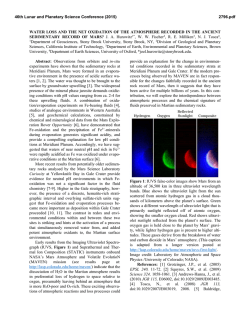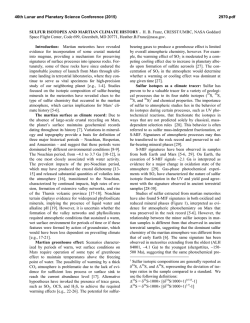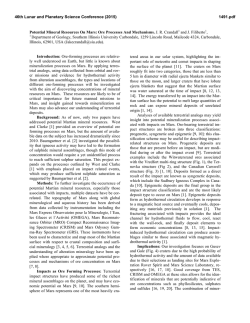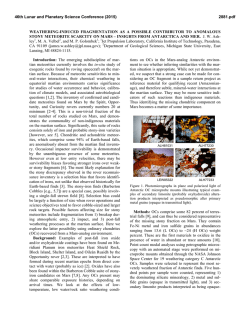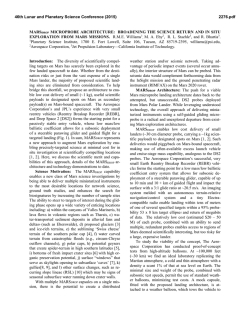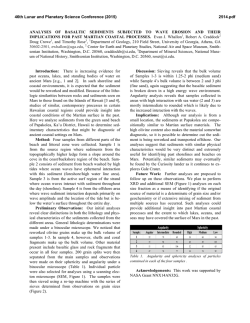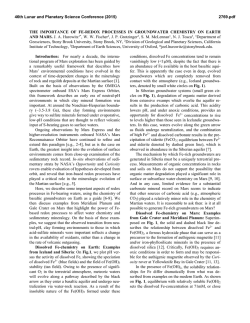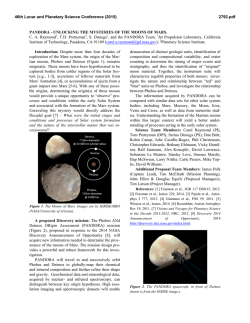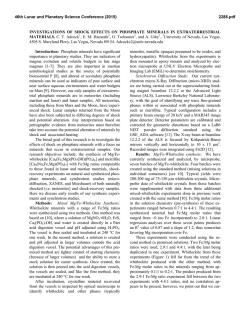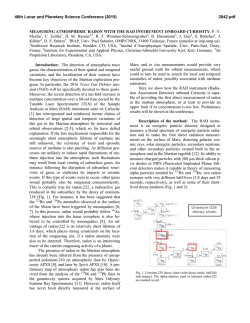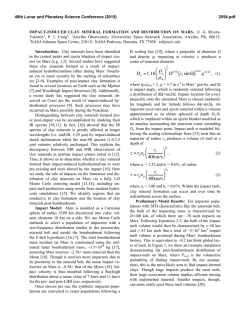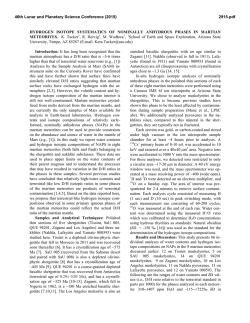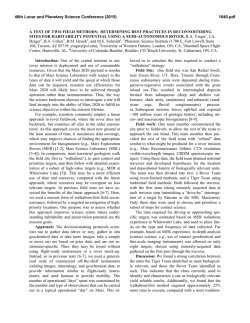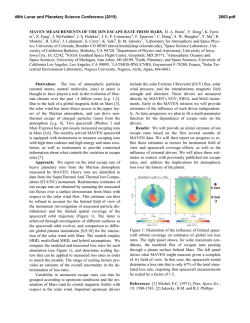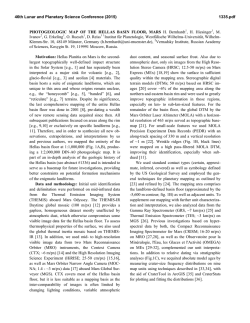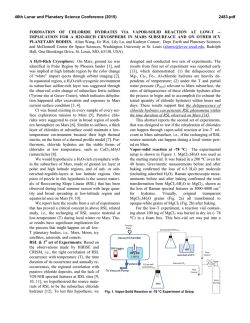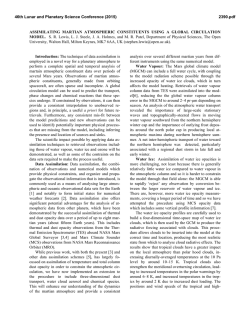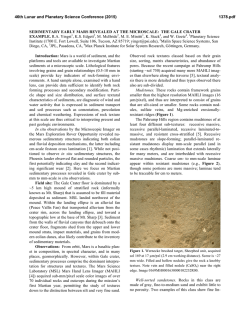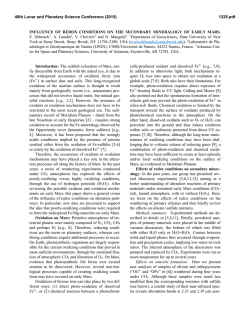
Exploring the Cold Icy Early Mars Hypothesis - USRA
46th Lunar and Planetary Science Conference (2015) 2860.pdf EXPLORING THE COLD ICY EARLY MARS HYPOTHESIS THROUGH GEOCHEMISTRY AND MINERALOGY. P. B. Niles 1, J. R. Michalski2-3, 1Astromaterials Research and Exploration Science, NASA Johnson Space Center, Houston, TX 77058; ([email protected]); 2Planetary Science Institute, Tucson, AZ. 3Natural History Museum London, London, UK. Introduction: While ancient fluvial channels have long been considered strong evidence for early surface water on Mars, many aspects of the fluvial morphology and occurrence suggest that they formed in relatively water limited conditions (compared to Earth) and that climatic excursions allowing for surface water might have been short-lived [1]. Updated results mapping valley networks at higher resolution have changed this paradigm, showing that channels are much more abundant and widespread, and of higher order than was previously recognized, suggesting that Mars had a dense enough atmosphere and warm enough climate to allow channel formation up to 3.6-3.8 Ga [2]. This revised view of the ancient martian climate might be broadly consistent with a climate history of Mars devised from infrared remote sensing of surface minerals, suggesting that widespread clay minerals formed in the Noachian, giving way to a sulfurdominated surface weathering system by ~3.7 Ga [3]. However, there are other indications that the warm wet conditions were not long lived or perhaps even necessary to explain the accumulated evidence. In the first place, during the early history of the Solar System, the Sun was much fainter than today making it difficult to support warm conditions on an early Mars [4]. Secondly, it has been difficult to show that the early Martian climate could support a warm enough climate to allow for active hydrological cycling although the roles of sulfur and hydrogen are currently being explored [5, 6]. Finally, while Noachian carbonates represent sequestered ancient CO2, they are not as widespread or abundant as might be expected if there truly was a sustained, dense atmosphere [7]. We propose the question: is it possible that many of aspects of the observed mineralogy and geomorphology could be explained by a cold hydrologic cycle, driven by surface and near-surface ice? This work attempts to outline a series of arguments supporting a cold early Mars, a hypothesis that deserves more serious consideration, especially in light of the geochemical and mineralogical data gathered thus far, including remote sensing, in-situ and meteorite data. Early Mars and Stable Isotope Data: We propose that most of the atmosphere had been lost by 4 Ga, indicating that much of the geochemical signature from atmospheric loss should already have occurred prior to 4 Ga. This is supported by evidence from martian meteorites which contain carbonates, and water from the Noachian, Hesperian and Amazonian. Equivalent heavy isotope enrichments in D/H and δ 13C are observed in the oldest martian meteorite (4.0 Ga) ALH 84001 as well as in the younger Nakhlite meteorites (~1.3 Ga) [8]. However, the most recent neasurements of the modern atmosphere by MSL [9] are heavier in carbon isotope composition and not consistent with the youngest martian meteorite carbonates. A recent study has suggested that while D/H ratios in the atmosphere may become enriched to as much as +5000‰, a moderately enriched crustal reservoir may contain much of the martian water and may have been established very early in martian history [10]. Early Mars and Phyllosilicate Formation: We suggest here that after most of the early atmosphere was lost to space prior to 4 Ga, a heterogeneous subsurface hydrosphere was active well into the Hesperian[11]. The largest fraction of clay minerals detected on Mars from orbit correspond to “crustal clays,” which were exhumed from the subsurface by meteor impact [11]. Therefore it is clear that aqueous activity did indeed occur in the martian subsurface. These crustal clays likely represent an important decoupling between the surface and subsurface hydrospheres [12]. There is no doubt that surface alteration also occurred in the Nochian, and even into the Hesperian and perhaps Amazonian [13]. While most of the clay detections correspond to Fe/Mg-rich clays, those clays are often capped by a thick (10s of meter) thick deposit of kaolinite-rich material. Such deposits are reminiscent of pedogenic horizons observed on Earth [14]. However, the thick deposits of kaolinite are mixed with Mg-bearing montmorillonite suggesting incomplete leaching – a departure from 46th Lunar and Planetary Science Conference (2015) the terrestrial analogy [15]. One possibility is that surface clays formed from meltwater beneath ancient surface ice at low temperatures resulting in incomplete leaching of the surface layer [15]. Carbonate minerals have also been detected in several locations on Mars, and largely represent subsurface formation envrionments in the Noachian [16, 17]. No substantial carbonate deposits have been detected in Hesperian aged materials which should be the primary reservoir for any dense CO2 atmosphere present at the Noachian-Hesperian boundary. Martian Sulfate Formation: The NoachianHesperian boundary has been suggested to represent a surge in warmer climatic conditions [1]. This is also the general time when phyllosilicate minerals cease to occur in the geologic record and sulfate minerals begin to appear. We propose that the sulfate record on Mars represents cold ice-weathering of fine grained martian dust that is deposited on the surface in ancient ice deposits. Sulfate minerals generally do not occur in putative paleo-lake basins, nor do they occur at the ends of proposed fluvial systems where water presumably pooled and evaporated. Instead sulfate minerals occur in association with chaos terrain, valles marineris, and large layered sediments on Mars. Many of these features lie in the headwaters of large outflow channels which have been attributed to melting of large ice deposits [18]. Likewise sulfate minerals appear associated with polar ice deposits in the northern polar region [19]. And perhaps most intriguing is that detailed in-situ investigations of sulfates have concluded that these materials formed in acidic, extremely low water/rock ratio conditions – lower than essentially any environment that is well known on Earth [20]. We suggest that small acidbrine pockets in ice could be consistent with this chemical constraint. Olivine has been shown to be capable of weathering at cryogenic temperatures in the presence of sulfuric acid [21], and the chemical composition of sulfate bearing sediments at Meridiani Planum is consistent with closed system weathering environment [22]. Conclusions: The geochemical evidence presented can be seen to interpret a cold, early Mars hypothesis where much of the aqueous activity happened prior to 4 Ga and largely in the subsur- 2860.pdf face. Atmospheric loss also occurred early on, and the atmosphere was not sufficiently thick to support a long lived warm climate (> 273 K) after 4 Ga. Finally, sulfates represent the best evidence for post 4 Ga aqueous activity but can be explained by having formed in cryogenic environments in ice deposits on the surface. Figure 1. Adapted from Michalski et al. [12]. Schematic diagram showing water and chemistry of martian crust under cold early Mars scenario. Clays are green and fluids are purple while light blue represents ice. References: 1. Irwin R.P., et al. (2005) Journal of Geophysical Research: Planets, 110, E12S15. 2. Hynek B.M., et al. (2010) J. Geophys. Res., 115, E09008. 3. Bibring J.P., et al. (2006) Science, 312, 400-404. 4. Sagan C. and Mullen G. (1972) Science, 177, 52-56. 5. Halevy I. and Head Iii J.W. (2014) Nature Geosci, advance online publication. 6. Ramirez R.M., et al. (2014) Nature Geosci, 7, 59-63. 7. Niles P., et al. (2013) Space Science Reviews, 174, 301-328. 8. Niles P.B., et al. (2010) Science, 329, 1334-1337. 9. Webster C.R., et al. (2013) Science, 341, 260-263. 10. Usui T., et al. (2015) Earth and Planetary Science Letters, 410, 140-151. 11. Ehlmann B.L., et al. (2011) Nature, 479, 53-60. 12. Michalski J.R., et al. (2013) Nature Geoscience. 13. Carter J., et al. (2013) Journal of Geophysical Research: Planets, 118, 831-858. 14. Noe Dobrea E.Z., et al. (2010) Journal of Geophysical Research: Planets, 115, E00D19. 15. Michalski J.R., et al. (2013) Icarus, 226, 816-840. 16. Michalski J.R. and Niles P.B. (2010) Nature Geoscience, 3, 751-755. 17. Ehlmann B.L., et al. (2008) Science, 322, 1828-1832. 18. Carr M.H. (1979) J. Geophys. Res., 84, 29953007. 19. Langevin Y., et al. (2005) Science, 307, 1584-1586. 20. Tosca N.J., et al. (2008) Science, 320, 1204-1207. 21. Niles P.B., et al. (2013) Lunar and Planetary Institute Science Conference Abstracts, 1719, 2526. 22. Niles P.B. and Michalski J. (2009) Nature Geoscience, 2, 215-220.
© Copyright 2025
